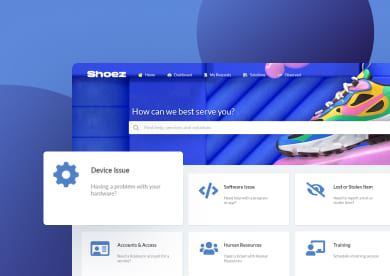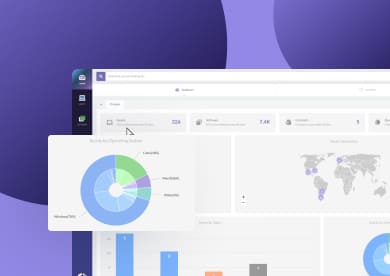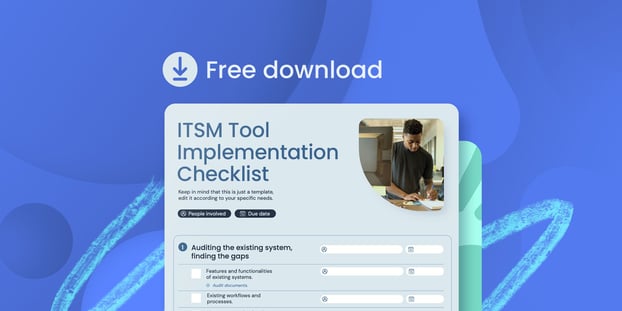Implementing a new service desk, however beneficial it may be, is fraught with challenges. In fact, if you google “Reasons why ITSM implementations fail,” there’s no dearth of articles and peer-reviewed research papers. But the truth is that the process is easier than it looks like – particularly if you have an ITSM implementation roadmap and this helpful ITSM implementation checklist we’re about to provide you with.
Difficulties are not exclusive to IT Service Management, though. A common ground of research (endorsed by organizations like Mckinsey) state that almost 70% of all digital transformation initiatives fail. With this in mind, if we switch back to the service desk implementation, there are many variables that determine its success – several of which we have no control over.
However, in our experience assisting clients throughout the world in their InvGate Service Management implementation, we know for a fact that there are also a couple of things that need to be checked off for it to be successful. Thus, we sat down with our implementation experts to put together this ITSM implementation template so that you can start working with much more confidence.
But before we start, don’t forget that the actual tasks included in the checklist will depend on your company’s needs and complexity, the team you work with, and (of course) the service desk software you choose – some are so hard that they can take months to be fully implemented, and others like InvGate Service Management only take a day to be operative.
Now that the disclaimers have been made, let’s begin!

ITSM implementation Plan: 5 steps

In order to be ready to embark on this task, the first thing you need to do is create an ITSM implementation strategy. It will consist of the following steps:
- Define your goals and expected outcomes - What do you want to achieve with ITSM?
- Plan the scope and resources - Where are you starting from?
- Design the service structure - How will you get from your current state to your desired state?
- Configure and deploy your ITSM solution - Put your plan into action!
- Monitor, and refine - Take stock of your progress and make changes as needed.
We broke down these five items into 18 ITSM implementation steps, along with the corresponding subtasks and deliverables, and we also added a space for you to assign a person responsible and a deadline for each one of them.
The goal of this itsm implementation roadmap is to help your organization transition from its current scenario to its desired future state. And this can be accomplished through the use of ITSM tools, processes, and best practices.
If you need more guidance, make sure to keep reading for a complete walk-through of what you should achieve at each stage.
ITSM implementation checklist
Before moving forward, make sure you’re equipped with the full list! download the full ITSM implementation checklist. You can use it to track every step of your implementation.
#1 Define goals and expected outcomes
Start with clarity. Define what your organization wants to achieve with ITSM. These goals will guide every decision throughout the implementation, from tool selection to how services are structured.
Begin by identifying gaps in your current IT support model. Where are delays happening? What causes confusion for end users? What workarounds do support teams rely on?
Next, gather input. Speak to people across the business — from help desk agents to managers to frequent requesters — and document their pain points. Their feedback can reveal needs that aren’t visible in data alone.
Once the problems are clear, define your objectives, for example, faster incident resolution, fewer manual escalations, better visibility into SLA performance,etc.
Use the information you get to prioritize features later. At this point, you should also identify how success will be measured and share those expectations with leadership.
Tasks in this stage:
- Finding gaps.
- Defining the desired outcomes.
- Collecting input.
- Defining goals.
#2 Plan the scope and resources
Once your goals are clear, begin translating them into a concrete plan. This includes outlining the timeline, estimating costs, and deciding which parts of the ITSM platform to use first.
Start by defining your budget. Consider more than just license costs — include training, implementation support, and future expansion. Then, create vendor selection criteria based on the features and integrations that match your goals.
If you’re already working with external providers, legal and procurement teams should be looped in early. Contract details (like service tiers, user limits, and onboarding support) can affect rollout speed and long-term value.
In parallel, define the features you’ll need. If improving request routing is a priority, focus on automation, queues, and user permissions. If SLA tracking is important, check how service levels and escalation paths are configured.
Tasks in this stage:
- Step 5: Budget.
- Step 6: Contracts with vendors.
- Step 7: Defining features.
3: Design the service structure
Now that you’ve chosen your tool and planned your scope, it’s time to design the structure that will support day-to-day operations.
Start with your ITSM workflows. Decide how incidents will be logged, routed, escalated, and resolved. Do the same for other services, such as change requests or onboarding tasks. Aim for consistency, but account for how each team works.
Then, build your Service Catalog. This document (or portal) describes what services are available to users, who delivers them, and how requests are fulfilled. It becomes the core of your self-service experience.
Define your SLAs next. For each service, agree on expected response and resolution times. Then, configure these targets in the platform so they can be tracked in real time.
Tasks in this stage:
- Step 8: Designing workflows.
- Step 9: Service Catalog.
- Step 10: SLAs.
If you have scarce resources, follow our advice and prioritize only your must-have features to develop an MVP. There’s plenty of time, later on, to add the other features as per the resources available.
#4 Configure and deploy the ITSM platform
With the design finalized, move on to implementation. This is where your ITSM tool gets configured and prepared for real use.
Start with hands-on setup: forms, automation rules, escalation paths, and ticket queues. If your platform supports role-based access, define who can view or manage which services. Test each configuration as you go, especially the workflows and rules tied to your most-used services.
Begin developing your knowledge base content, too. Even a small collection of how-to articles can reduce ticket volume at launch and give users confidence in the new system.
You’ll also need to train your teams. Of course, you can save most of the trouble if you get an intuitive ITSM solution like InvGate Service Management. But even though, it might be a good idea to create training material detailing every process, as well as a plan to train your team to use the system effectively.
Agents should know how to use queues, manage tickets, and access reports. Service owners should understand how to approve, assign, and analyze. End-users need basic guidance on submitting requests and searching for answers.
Tasks in this stage:
- Step 11: Training.
- Step 12: Incident Management.
- Step 13: Check if the must-have features are tested and developed.
#5 Monitor and refine
After the system is configured and teams are trained, prepare to go live. Decide whether you’ll release all features at once or introduce them gradually.
During the rollout, monitor adoption. Track how many users are submitting requests, where tickets are getting stuck, and whether SLAs are being met. Run reports frequently and meet with stakeholders to review what’s working and what needs adjustment.
Start applying automation once you have some usage data. For example, you might auto-route low-priority incidents, send alerts for overdue requests, or pre-fill forms based on past tickets. Set up integrations with systems like email, identity management, or monitoring tools to reduce context-switching.
Treat this phase as a learning period. Keep gathering feedback, update your knowledge base often, and prepare to make changes based on how people actually use the platform — not just how you expected them to.
Tasks in this stage:
- Step 14: Rolling out.
- Step 15: Build a knowledge base.
- Step 16: Automation and integrations.

ITSM implementation best practices
Many ITSM projects fall short not because of the software, but because of how the implementation is handled. Below are three practical principles that make a measurable difference across all types of organizations.Work iteratively, not all at once
#1 Work iteratively, not all at once
Trying to “go live” with every process, workflow, and feature at the same time creates more problems than it solves. It overwhelms teams, makes testing less reliable, and slows down adoption.
Instead, break the implementation into smaller, manageable phases. For example:
-
Start with Incident Management and a basic Service Catalog.
-
Add Change Management, SLAs, and automation after those are stable.
-
Expand to areas like Asset Management or Self-Service once the platform is already in use.
Each wave of implementation gives your team space to test, adjust, and improve without disrupting service.
Working this way also makes it easier to course-correct. If a process isn’t being used as expected or agents are skipping steps, you can catch it early and adapt.
#2 Prioritize people, not just tools or processes
ITSM isn’t only about what the tool can do — it’s about how your people use it day-to-day. Successful implementations reflect how teams actually work, not just how the process looks on paper.
That starts with listening. Gather input from the agents, team leads, and requesters who interact with IT services regularly. Their feedback should directly influence how you design forms, approval flows, or service categories.
You’ll also need to invest in training, but not just as a one-time workshop. Build internal support materials that people can refer back to. Assign team leads or champions who can support their peers after launch.
And don’t forget user experience. The simpler it is for users to submit a request or find an article, the more they’ll engage with the new system — and the smoother the rollout will be.
Use change governance that fits your reality
You don’t need a formal Change Advisory Board for every small rollout — but you do need structure. Implementation projects benefit from change governance that reflects your actual decision-making flow and team structure.
Set up clear roles:
-
Who approves changes to workflows?
-
Who owns the Service Catalog?
-
Who signs off on automation or integrations?
Decisions should be documented, communicated, and easy to revisit. That reduces confusion when things shift — and they will.
Governance also includes communication. Keep leadership updated with short, relevant updates. Inform support teams of changes before they go live. The more consistent your communication, the fewer surprises during rollout.
And if you’re iterating, update stakeholders after each wave. Treat feedback seriously and make adjustments when needed. Change control doesn’t have to mean red tape — it just means no one is flying blind.
Bottom line
Our ITSM implementation strategy is simple: we take a step-by-step approach that starts with understanding your current state, continues with a thorough ITSM implementation checklist and ends with you achieving your desired state.
And as if that weren’t enough, we walked you through each step of the process so that you have more information about what’s expected and what you should achieve – without needing an external ITSM consultant.
We promised that the service desk implementation process didn't necessarily have to be a headache – or take forever. In order for you to succeed, you need to start on the right foot, and that means setting up a realistic assessment and choosing the right ITSM tool.
We know for a fact that these two items are unnegotiable. And that’s why we provide not only an easy-to-implement service desk but also a Support Team ready to walk you through the implementation path. Want to see it for yourself? You can schedule a call with our teams now; you won’t regret it.
















